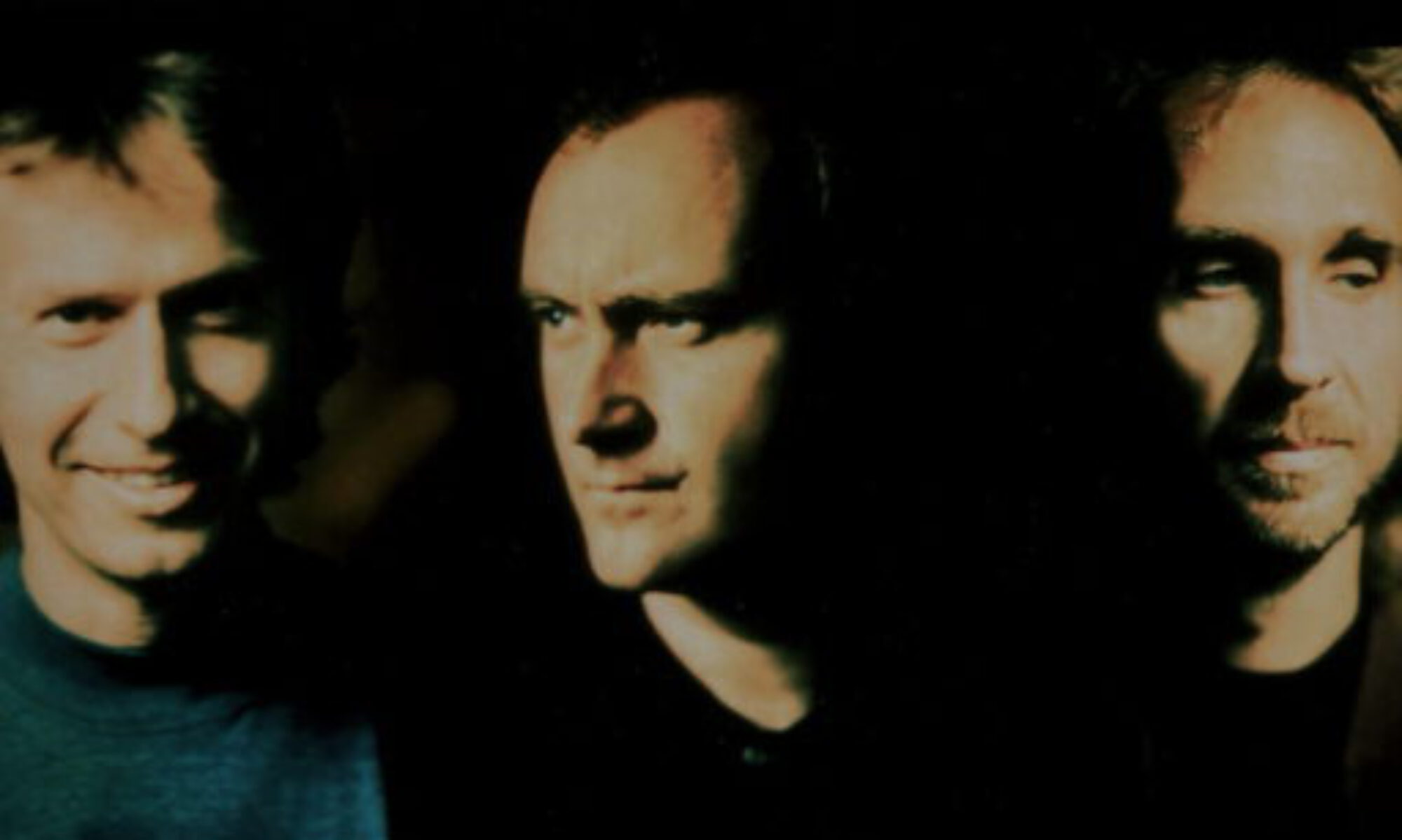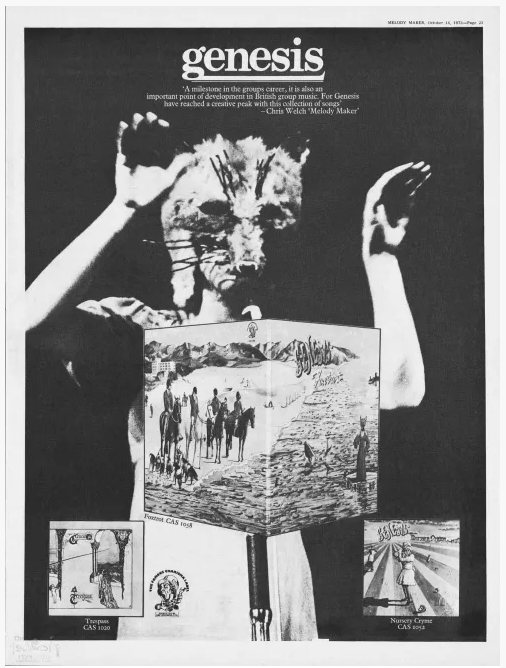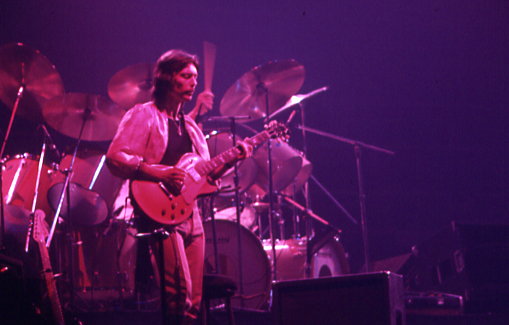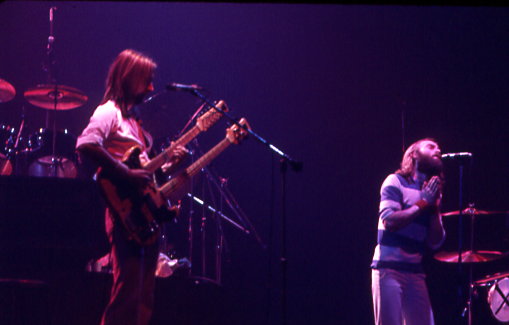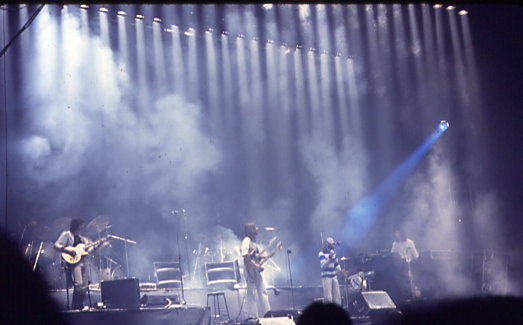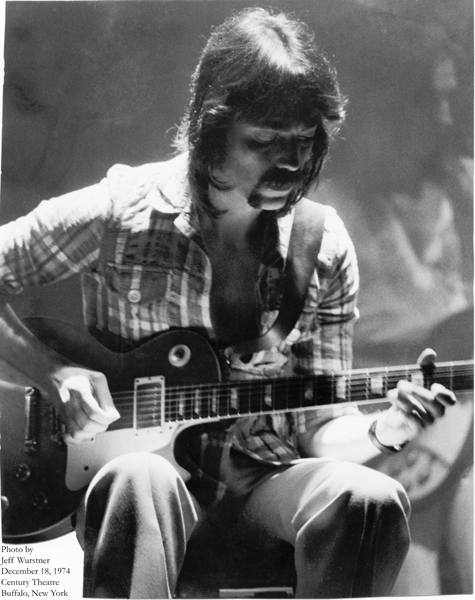On 28 September 1972, Peter Gabriel appeared onstage during ‘The Musical Box’ with the foxes’ head and the red dress from the Foxtrot album cover.
Continue reading “Dublin, 28 Sept 1972: Peter Gabriel wears a fox head and a red dress”Steve Hackett’s Last Show with Genesis
On July 3, 1977, Genesis played the final show of their Wind & Wuthering tour, unaware that it would also be Steve Hackett’s last performance with the band.
Wind & Wuthering and Growing Tensions
Released in December 1976, Wind & Wuthering was Genesis’s second album following Peter Gabriel’s departure. With Phil Collins now stepping confidently into the role of lead vocalist, the band had successfully reinvented itself as a four-piece. Collins had already proven he could carry the frontman role with A Trick of the Tail and the subsequent 1976 tour.
By this point, songwriting duties were largely shared between Tony Banks and Mike Rutherford, while Phil focused more on arrangements and performance. Steve Hackett, however, was growing increasingly frustrated. He felt that his musical ideas were often overlooked, and after the 1977 tour, he made the decision to leave Genesis.
The Wind & Wuthering Tour
The 1977 tour was one of Genesis’s biggest yet, taking them across Europe, the US, and for the first time, South America. They were joined by American drummer Chester Thompson, who would become a fixture in the live lineup for decades.
That year, the band reached new heights in live performance and was even voted “Best Live Group” in 1977. Much of that era’s power was captured on the double live album Seconds Out.
The Final Show: July 3, 1977, Munich
Genesis closed out the tour with a concert at Munich’s Olympiahalle. They opened with Squonk, followed by One for the Vine, a Tony Banks epic from the new album. The rare track Inside and Out from the Spot the Pigeon EP was also included, having appeared on select European dates.
Highlights of the show included The Carpet Crawlers, I Know What I Like, and Supper’s Ready, songs that had evolved significantly since Gabriel’s departure. The band had also begun experimenting with medleys, a trend that continued on this tour: Dance on a Volcano merged seamlessly into Los Endos, while The Lamb Lies Down on Broadway was paired with the climactic ending of The Musical Box.
And of course, Firth of Fifth made the setlist, featuring Hackett’s iconic guitar solo. None of the fans, or even the band members, knew it would be the last time they’d see Steve Hackett perform it live with Genesis.
Steve Hackett’s Departure
Steve had already released a solo album by this point, showcasing ideas that had not made it onto Genesis records. During the four-piece era, he had pushed for a guaranteed portion of writing credits on each album, a request the others declined, committed as they were to being a fully democratic group.
In July 1977, while mixing Seconds Out, Hackett found himself exhausted by the constant repetition of songs like I Know What I Like. After months on the road and in front of crowds of 20,000 people, he began to feel creatively stifled. The challenge was gone.
So one day, he picked up the phone and called Mike Rutherford to say he was leaving. Mike, aware of Steve’s growing dissatisfaction, did not try to change his mind.
Shortly afterward, Phil Collins happened to drive past Steve near Trident Studios, where they were mixing the album. Phil invited him into the car, but Steve acted strangely, saying only, “Talk to Mike, he’ll explain,” before walking away. When Phil arrived at the studio, Mike and Tony told him Steve had officially left the band.
The Band Carries On
Genesis continued mixing Seconds Out as a trio, then returned to the studio to begin work on their next album. From this point forward, Genesis would remain a three-piece studio band, while Steve Hackett would embark on a successful solo career.
Title photo: Genesis Steve Hackett. Source: Wikimedia Commons, Jean-Luc / CC-BY-SA-2.5 (https://creativecommons.org/licenses/by/3.0). Originally posted to Flickr as Genesis.
Phil Collins’ First Show as Genesis Frontman
In 1975, Peter Gabriel left Genesis, leaving the band without a lead singer. After auditioning several vocalists without success, drummer Phil Collins reluctantly stepped up to take on the role. He sang on A Trick of the Tail (1976), the band’s first album after Gabriel’s departure. But while he handled the studio vocals, he wasn’t eager to become the band’s frontman on tour.
This is the story of how Phil Collins took center stage.
Phil Collins Didn’t Want to Be the Singer
A Trick of the Tail proved that Genesis could continue without Peter Gabriel. The album was a success, and Phil’s vocals shone on both the heavier tracks like Dance on a Volcano and the softer moments of Ripples.
Yet, despite his strong performance, Phil had no desire to be the band’s singer. He saw himself first and foremost as a drummer.
‘I’ve always felt the singer was the cheapest gig in the band, ’cause all they had to do was look good and wiggle their bum,’ he later admitted. ‘I always wanted the most respectable part in the group, which was of course the drummer.’1
When it came time to tour the album, Phil hesitated. He agreed to take on the lead vocals under one condition: he needed a drummer he could trust. That drummer was his friend Bill Bruford of Yes, who joined Genesis for the tour.
On March 26, 1976, Genesis played their first show with Phil Collins as frontman in London, Ontario.
Could He Replace Peter Gabriel?
Fans knew from the album that Phil could sing, but how would he handle the older material? Fortunately, his voice was naturally similar to Peter Gabriel’s, and he had already sung backing vocals on many classic Genesis tracks. His performances of songs like The Lamb Lies Down on Broadway, Firth of Fifth, and Supper’s Ready proved he was up to the challenge.
The new material was also well received. On Robbery, Assault & Battery, Phil brought the song’s Victorian-era story to life with his acting skills, while the instrumental Los Endos became even more powerful live, thanks to the addition of a second drummer.
Bringing in Bill Bruford was the right move. As a respected figure in progressive rock, his presence reassured fans. His intricate playing added a new dimension to Genesis’ music. While Bruford and Collins played off each other in a more unpredictable way, later drummer Chester Thompson would lock in with Phil to create the band’s signature double-drumming style.
A Warm Welcome for the ‘New’ Singer
Genesis fans wanted this lineup to succeed – and they embraced Phil’s new role. He brought a down-to-earth charm and a touch of Monty Python-style humor to the stage. The band seemed more relaxed, with the spotlight no longer focused solely on the singer.
During I Know What I Like, Phil got the other members involved, playfully placing hats on their heads and sharing a mic with Mike Rutherford. He even debuted his now-famous tambourine dance.
Where Peter Gabriel had been the mysterious storyteller, Phil Collins was the approachable everyman. He didn’t weave surreal tales; he spoke to the audience directly. Even Peter himself later said he was happy that Phil took over, recognizing that Phil was a stronger technical singer and had a natural connection with audiences.
Phil was nervous that first night in London, Ontario, but the show was a success. Genesis continued with him as their frontman for the next two decades – except for a brief period in the ’90s when Ray Wilson took over after Phil’s departure.
But that’s another story.
Title photo: Mike Rutherford and Phil Collins of Genesis in 1977. Source: Wikimedia Commons, Jean-Luc Ourlin from Toronto ontario, Canada / CC BY (https://creativecommons.org/licenses/by/3.0)
- Genesis – A History ↩︎
Genesis Kicks Off the Wind & Wuthering Tour at the Rainbow Theatre on 1 January 1977
On January 1, 1977, Genesis began their highly anticipated Wind & Wuthering tour with a series of three sold-out performances at London’s iconic Rainbow Theatre. These shows marked the beginning of a new chapter for the band, being the first with Chester Thompson as their touring drummer and the last with guitarist Steve Hackett. The stakes were high, and the performances lived up to every expectation, setting the tone for what would become one of the band’s most ambitious tours.
A New Era for Genesis
By the time Genesis took to the stage at the Rainbow, they were riding the wave of their recently released album, Wind & Wuthering. This was their second studio effort since Peter Gabriel’s departure and demonstrated the band’s evolving sound, shaped primarily by Tony Banks and Mike Rutherford. While Phil Collins had already proven himself a formidable frontman on A Trick of the Tail and its subsequent tour, Wind & Wuthering solidified the band’s status as a dominant force in progressive rock.
The Rainbow shows also introduced fans to a new dynamic on stage. Chester Thompson, who had played with Frank Zappa and Weather Report, stepped into the role of live drummer. Despite having just ten days of rehearsals to learn an extensive and complex setlist, Thompson impressed with his technical prowess and adaptability. Though initial reviews were mixed—with some critics finding his style less “exciting” than Bill Bruford’s—his chemistry with Collins and the band grew stronger as the tour progressed.
The Opening Night: 1 January 1977
Genesis opened their first show with “Eleventh Earl of Mar” from the new album, setting the stage with energy and precision. Fans were also treated to other Wind & Wuthering tracks, including the jazzy instrumental “…In That Quiet Earth” and the poignant ballad “Afterglow,” where Collins and Thompson recreated a stunning drum fill inspired by Zappa’s Roxy & Elsewhere. The setlist also revisited classic fan favorites like “Supper’s Ready” and “The Musical Box,” which now had a fresh groove thanks to Thompson’s jazz-rock sensibilities.
The performances weren’t just about the music. Genesis debuted a state-of-the-art stage setup, featuring computer-controlled laser lights and Boeing 747 landing lights, creating a mesmerizing visual spectacle. Despite the rise of punk rock, which critics claimed was overshadowing progressive rock, the demand for Genesis was undeniable—80,000 fans applied for just 8,000 tickets to the Rainbow shows.
Reflections on the Show
Peter Gabriel, who attended the Rainbow performances, reportedly sympathized with Thompson’s challenge of adapting to Genesis’ intricate material on short notice. However, the drummer’s confidence and skill became evident as he added his own flair to the band’s repertoire. Even tracks like “Squonk,” which some felt fell short compared to its studio version, showcased Thompson’s steady hand and growing familiarity with the material.
The new lineup’s energy was palpable. Tony Banks’ epic “One for the Vine” stood shoulder to shoulder with Genesis’ older masterpieces, while lighter moments like “All in a Mouse’s Night” brought humor to the set. The extended version of “I Know What I Like” had the audience grooving, proving that Genesis was still evolving their sound even in live performances.
A Turning Point for Genesis
The three nights at the Rainbow Theatre were a triumphant start to a journey that would take the band across Europe, North America, and South America. It was during this tour that Genesis cemented their reputation as one of the best live acts of the era, a feat recognized when they were voted “Best Live Group” in 1977.
Yet, this tour also marked an ending. Steve Hackett, whose frustrations over his role in the band had been simmering for some time, left after the tour. His departure would transform Genesis into a trio for their subsequent album, …And Then There Were Three…, signaling the end of their progressive rock era and the start of a new phase in their sound.
“Best Live Band” in 1977
The recordings from this tour were later featured on the live album Seconds Out. These concerts captured Genesis at a pivotal moment, balancing the old and the new while navigating internal changes and external pressures. For the fans lucky enough to be there, the Rainbow shows remain legendary—a testament to Genesis’ ability to innovate, adapt, and deliver unforgettable live experiences.
As Chester Thompson would later recall the Rainbow shows: “I remember there was an energy, a buzz unlike anything I felt. It wasn’t a huge venue, but the crowd was really into it. The music for me was again a challenge, because it was just so unfamiliar to me.”1
Indeed, the Rainbow shows of January 1977 were more than just concerts—they were a defining moment in the history of Genesis.
Title photo: Genesis_(the_band). Source: Wikimedia Commons, Jean-Luc / CC-BY-SA-2.5 (https://creativecommons.org/licenses/by/3.0).
Sources
Bowler, Dave; Dray, Bryan (1992): Genesis. A biography. London: Sidgwick & Jackson.
CHESTER THOMPSON FULL INTERVIEW : HOW HE WENT FROM ZAPPA TO DRUMMING WITH GENESIS & PHIL COLLINS.
Frischvers, Richard, ‘Wind & Wuthering’. Circus (31 March 1977), pp. 58–60, https://thegenesisarchive.co.uk/circus-magazine-wind-and-wuthering-feature-31st-march/, archived from the original on 11 October 2015.
Platts, Robin (2007): Genesis. Behind the lines, 1967-2007. Burlington, Ont., Canada: Collectors Guide Pub.
Thompson, Dave (2005): Turn it on again. Peter Gabriel, Phil Collins & Genesis. San Francisco: Backbeat Books.
- CHESTER THOMPSON FULL INTERVIEW : HOW HE WENT FROM ZAPPA TO DRUMMING WITH GENESIS & PHIL COLLINS. ↩︎
Steve Hackett’s First Gig with Genesis: A Nervous Start to a New Era
On January 14, 1971, Genesis played a gig at University College, London, marking the live debut of their new guitarist, Steve Hackett. For Hackett, this night would become a memorable, albeit nerve-wracking, chapter in his career with the band.
Joining Genesis: A Classical Touch
Steve Hackett joined Genesis in late 1970, following an audition that showcased his unique style. Hackett brought a blend of classical, jazz, and blues influences, developed since his childhood in Pimlico. Inspired by The Beatles, Bach, and George Martin’s orchestrations, Hackett’s approach to guitar was more compositional than flashy—something Tony Banks and Peter Gabriel recognized during his audition. “We thought that some of what he did would fit really well,” Banks later recalled, praising Hackett’s classical edge.1
Before the audition, Hackett had advertised in Melody Maker for years and had gained limited recording experience with the band Quiet World. But when he joined Genesis, he knew this was his opportunity to make a lasting impact.
The Big Night: January 14, 1971
By the time Hackett stepped onstage for the first time as a member of Genesis, the band had already begun evolving into a cohesive unit. Phil Collins, who had joined a few months earlier, had quickly become a vital part of their sound. Mike Rutherford, having the dual roles on bass and rhythm guitar, was developing as a rhythm guitarist, while Peter Gabriel and Tony Banks remained the creative core.
The University College gig, however, was not an auspicious start. Hackett was understandably nervous, and the evening presented several challenges. Equipment problems—a recurring issue for Genesis in their early days—plagued the performance. Hackett’s borrowed fuzz box malfunctioned.
“I found his playing a little stiff”, Phil Collins later said, “but I guess that was the Fripp influence. I like Robert, I played with him on his solo album, he was always very good to me, but I don’t think he’s a very intuitive player. He was a kind of sound man without the feeling. I think Steve took a little bit of that into his music. It wasn’t a groove, you know, and as a drummer that was really where I lived.”2
Adding to the chaos on that first night, Collins decided to test the limits of his ability to drum after consuming Newcastle Brown Ale. According to Collins, “I was doing perfect drum fills – three inches to the left of every drum.”3 The resulting performance left the band frazzled.
Misunderstandings and Lessons Learned
Backstage, Hackett misinterpreted a heated discussion among the band members as criticism of his performance. In reality, Banks and Rutherford were admonishing Collins for his ale-induced drumming experiment. Sound mixer Richard MacPhail tried to reassure Hackett after the gig, leading him offstage after saying, “It’s over now, Steve.”4 Despite his doubts, Hackett’s contributions impressed the group, and they encouraged him to stay.
Building Momentum
The difficult debut was only the beginning. Hackett and Rutherford soon developed intricate ideas for their twin twelve-string guitars, which was a hallmark of Genesis’ sound. The band spent the rest of 1971 refining their music, writing and rehearsing material for what would become their first album with Hackett, Nursery Cryme. During the “Six Bob Tour” with Lindisfarne and Van der Graaf Generator, Genesis started gaining traction with audiences, performing in town halls and small venues across Britain.
By mid-1971, Genesis was playing bigger stages, including the Reading Festival and their first overseas gig in Belgium. Hackett’s insistence on acquiring a Mellotron MK II and new equipment pushed the band towards a more sophisticated sound.
A New Genesis
Hackett’s intricate guitar work and compositional mindset enriched Genesis’ music. Though his first gig was rocky, Hackett proved to be a vital addition to the band, helping shape their identity.
While that night at University College on January 14, 1971, may not have gone as planned, it set the stage for the musical evolution to come.
Title photo: Wikimedia Commons, Jeff Wurstner / CC BY (https://creativecommons.org/licenses/by/3.0)
Sources
Fielder, Hugh; Sutcliffe, Phil, The book of Genesis. (London: Sidgewick & Jackson, 1984).
PHIL COLLINS FULL 2-HOUR INTERVIEW: HIS CAREER WITH GENESIS TO 1980.
STEVE HACKETT FULL INTERVIEW- Revised : MY GENESIS YEARS.
TONY BANKS UNFILTERED: GENESIS KEYBOARD PLAYER & COMPOSER IN CONVERSATION . FULL.. 1 Hour 53 Mins.
